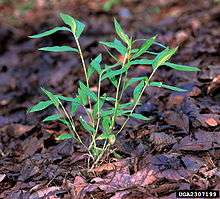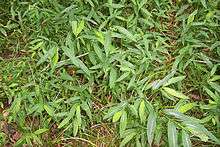Microstegium vimineum
| Japanese stiltgrass | |
|---|---|
 | |
| Single specimen of Japanese Stiltgrass (Microstegium viminium), a non-native invasive plant in the United States. | |
| Scientific classification | |
| Kingdom: | Plantae |
| (unranked): | Angiosperms |
| (unranked): | Monocots |
| (unranked): | Commelinids |
| Order: | Poales |
| Family: | Poaceae |
| Subfamily: | Panicoideae |
| Tribe: | Andropogoneae |
| Genus: | Microstegium |
| Species: | M. vimineum |
| Binomial name | |
| Microstegium vimineum (Trin.) A. Camus | |
Microstegium vimineum, commonly known as Japanese stiltgrass or Nepalese browntop, is an annual grass that is common in a wide variety of habitats and is well adapted to low light levels.
Geographic range
It is native in much of South Asia, East Asia as well as parts of Southeast Asia. It can be found from Iran in the west, east to China, south to the Philippines, and has since moved to the United States.
Description
It typically grows to heights between 40 and 100 cm (1.3 and 3.3 ft) and is capable of rooting at each node. The plant flowers in late summer and produces its seeds in the form of a caryopsis shortly thereafter.[1][2] It is quite similar to and often grows along with the North American grass Leersia virginica, but L. virginica lacks the distinctive silver stripe on the center of the leaf that is present on Japanese stiltgrass and also flowers one to two months earlier.[1][3]
Ecology as an invasive species
The plant was accidentally introduced into the U.S. state of Tennessee around 1919 as a result of being used as a packing material in shipments of porcelain from China. It has spread throughout the Southeastern US and is now found in 26 states.[4] Microstegium viminium most commonly invades along roads, floodplain and other disturbed areas, but will also invade undisturbed habitats.[5][6][7] Whitetail deer, which do not browse the grass, may facilitate spread by browsing on native species and thereby reducing competition for the exotic plant.[8] Grazing herbivores, such as cattle, will avidly graze this C4protein warm season grass. Invasion of Microstegium can reduce growth and flowering of native species,[9] suppress native plant communities,[10] alter and suppress insect communities,[11] slow plant succession[12] and alter nutrient cycling.[13][14] However, removal of Microstegium can lead to recovery of native plant communities.[15][16][17]
Control
Microstegium vimineum is a warm season grass which can be controlled with pre-emergent herbicides targeted for crabgrass. Post emergent controls can also be successful, such as Calcium acid methanearsonate 8.4% Ortho "Weed-b-Gon" Crabgrass killer for lawns,[3] which contains 2,4-D, and Acclaim Extra as well. Unless noted, surfactants should be added to herbicides for better control. In addition to herbicides, hand weeding and mowing are among the most successful methods of removal. In order to be effective, mowing must be performed before the plants go to seed.[18]
Gallery
-

Microstegium vimineum at Congaree National Park, South Carolina, United States
-
Microstegium vimineum at Devil's Den State Park, Arkansas, USA
-
Microstegium vimineum near a stream in Central New Jersey, USA.
-

Illustration from Wetland flora: Field office illustrated guide to plant species
-

Microstegium vimineum seeds, caryopses, USA.
References
- 1 2 Thieret, John W. (2006), "Mictrostegium", in Flora of North America Editorial Committee, eds. 1993+, Flora of North America, 25, New York & Oxford: Oxford University Press
- ↑ Chen, Shou-liang ; Phillips, Sylvia M. (2007), "Microstegium vimineum", in Wu, Z. Y.; Raven, P.H.; Hong, D.Y., Flora of China, 22, Beijing: Science Press; St. Louis: Missouri Botanical Garden Press, p. 593, retrieved 2007-07-14
- 1 2 Swearingen, Jil M.; Adams, Sheherezade (2006). "Japanese Stiltgrass". Plant Conservation Alliance's Alien Plant Working Group. National Park Service. Retrieved 2007-06-27.
- ↑ USDA, NRCS. 2012. The PLANTS Database (http://plants.usda.gov, 19 August 2012). National Plant Data Team, Greensboro, NC 27401-4901 USA.
- ↑ Redman, D.E. 1005. Distribution and habitat types for Nepal Microstegium (Microstegium vimineum) in Maryland and the District of Columbia. Castenea, 60:270-275
- ↑ Cole, P.G. and J.G. Weltzin. 2005. Environmental correlates of the distribution and abundance of Microstegium vimineum in east Tennessee. Southeastern Naturalis, 3:545-563.
- ↑ Moretensen, D.A., E.S.J. Rauschert, A.N Nord and B.P. Jones. 2009. Forest roads facilitate the spread of invasive plants. Invasive Plant Science and Management. 2:191-199
- ↑ Knight TM, Dunn JL, Smith LA, Davis J, Kalisz S (2009) Deer facilitate invasive plant success in a Pennsylvania forest understory. Nat Areas J 29:110–116
- ↑ Bauer, J.T. and Flory, S.L. 2011. Suppression of the woodland herb Senna hebecarpa by the invasive grass Microstegium vimineum. American Midland Naturalist. 165:105-115.
- ↑ Flory, S.L. and K. Clay. 2010. Non-native grass invasion alters native plant composition in experimental communities. Biological Invasions 12:1285-1294
- ↑ Simao, M.C., S.L. Flory, and J.A. Rudgers. 2010. Experimental plant invasion reduces arthropod abundance and richness across multiple trophic levels. Oikos 119:1553-1562.
- ↑ Flory, S.L. and K. Clay. 2010. Non-native grass invasion suppresses forest succession. Oecologia 164:1029-1038.
- ↑ Ehrenfeld, J.G. 2003 Effects of exotic plant invasions on soil nutrient cycling processes. Ecosystems 6:503–523
- ↑ Lee, M., S.L. Flory, and R. Phillips. 2012. Positive feedbacks to growth of an invasive grass through alteration of nitrogen cycling. Oecologia. DOI: 10.1007/s00442-012-2309-9
- ↑ Flory, S.L. 2010. Management of Microstegium vimineum invasions and recovery of resident plant communities. Restoration Ecology. 18:103-112
- ↑ Flory, S.L. and K. Clay. 2009. Invasive plant removal method determines native plant community responses. Journal of Applied Ecology. 4:434-442.
- ↑ DeMeeste, J.E., Richter, D.D. 2010. Restoring restoration: removal of the invasive plant Microstegium vimineum from a North Carolina wetland. Biological Invasions 12:781–793
- ↑ Kleczewski, N., Flory, S.L. and Nice, G. 2011. An Introduction to Microstegium vimineum (Japanese stiltgrass/Nepalese browntop) an Emerging Invasive Grass in the Eastern United States. Indiana University Department of Biology. www.btny.purdue.edu/weedscience/2011/Microstegium-01.pdf.
External links
| Wikispecies has information related to: Microstegium vimineum |
| Wikimedia Commons has media related to Microstegium vimineum. |
- NPS Plant Invaders of Mid-Atlantic Natural Areas: Japanese Stilt Grass
- Maine Invasive Plants: Japanese Stilt Grass
- Species Profile- Japanese Stilt Grass (Microstegium vimineum), National Invasive Species Information Center, United States National Agricultural Library. Lists general information and resources for Japanese Stilt Grass.
- Invasive Plant Council of New York: Japanese Stiltgrass